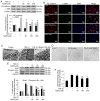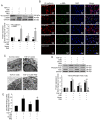Protective effect of hydrogen sulfide on monocrotaline‑induced pulmonary arterial hypertension via inhibition of the endothelial mesenchymal transition
- PMID: 31573044
- PMCID: PMC6844600
- DOI: 10.3892/ijmm.2019.4359
Protective effect of hydrogen sulfide on monocrotaline‑induced pulmonary arterial hypertension via inhibition of the endothelial mesenchymal transition
Abstract
Endothelial‑to‑mesenchymal transition (EndMT) serves an important role in the vascular remodeling of pulmonary arterial hypertension (PAH). However, little is known about the correlation between hydrogen sulfide (H2S), a protective gaseous mediator in PAH and the process of EndMT. Male Sprague‑Dawley rats (10 weeks old) received a single dose of monocrotaline (MCT; i.p., 60 mg/kg) and were randomly treated with NaHS [an H2S donor; intraperitoneal (i.p.) 1 mg/kg/day], DL‑propagylglycine (an inhibitor of H2S synthesis; PAG; i.p., 10 mg/kg/day) or saline, 7 days after MCT injection. Rats were sacrificed 21 days after MCT injection. A selection of human pulmonary artery endothelial cells (HPAECs) were pretreated with NaHS or saline and stimulated with transforming growth factor (TGF)‑β1 (10 ng/ml), and the other HPAECs were transfected with a cystathionine γ‑lyase (CSE, an H2S synthesizing enzyme) plasmid and subsequently stimulated with TGF‑β1. NaHS was indicated to inhibit EndMT and PAH progression by inhibiting the induction of the nuclear factor (NF)‑κB‑Snail pathway. In contrast, the depletion of H2S formation by PAG exacerbated EndMT and PAH by activating NF‑κB‑Snail molecules. In HPAECs, NaHS dose‑dependently inhibited TGF‑β1‑induced EndMT and the activation of the NF‑κB‑Snail pathway. Transfection with a CSE plasmid significantly repressed TGF‑β1‑induced expression of the mesenchymal marker and upregulated the expression of the endothelial marker, which was accompanied by the suppression of the NF‑κB‑Snail pathway. The inhibitory effect of CSE overexpression on TGF‑β1‑induced EndMT was significantly reversed by pretreatment with PAG. In conclusion, the current study provides novel information elucidating the beneficial effect of H2S on PAH through inhibiting the induction of the NF‑κB‑Snail pathway and the subsequent process of EndMT in pulmonary arteries.
Figures






Similar articles
-
Knockdown of eIF3a alleviates pulmonary arterial hypertension by inhibiting endothelial-to-mesenchymal transition via TGFβ1/SMAD pathway.J Transl Med. 2025 May 9;23(1):524. doi: 10.1186/s12967-025-06505-3. J Transl Med. 2025. PMID: 40346622 Free PMC article.
-
miR-181b-5p inhibits endothelial-mesenchymal transition in monocrotaline-induced pulmonary arterial hypertension by targeting endocan and TGFBR1.Toxicol Appl Pharmacol. 2020 Jan 1;386:114827. doi: 10.1016/j.taap.2019.114827. Epub 2019 Nov 14. Toxicol Appl Pharmacol. 2020. PMID: 31734320
-
H2S inhibits pulmonary arterial endothelial cell inflammation in rats with monocrotaline-induced pulmonary hypertension.Lab Invest. 2017 Mar;97(3):268-278. doi: 10.1038/labinvest.2016.129. Epub 2016 Dec 12. Lab Invest. 2017. PMID: 27941756
-
Endothelial-to-Mesenchymal Transition in Pulmonary Arterial Hypertension.Antioxid Redox Signal. 2021 Apr 20;34(12):891-914. doi: 10.1089/ars.2020.8169. Antioxid Redox Signal. 2021. PMID: 32746619 Free PMC article. Review.
-
Pathobiology of pulmonary artery hypertension: role of long non-coding RNAs.Cardiovasc Res. 2020 Oct 1;116(12):1937-1947. doi: 10.1093/cvr/cvaa050. Cardiovasc Res. 2020. PMID: 32109276 Review.
Cited by
-
Jagged/Notch proteins promote endothelial-mesenchymal transition-mediated pulmonary arterial hypertension via upregulation of the expression of GATAs.J Cell Mol Med. 2023 Apr;27(8):1110-1130. doi: 10.1111/jcmm.17723. Epub 2023 Mar 20. J Cell Mol Med. 2023. PMID: 36942326 Free PMC article.
-
Hydrogen Sulfide Metabolism and Pulmonary Hypertension.Cells. 2021 Jun 12;10(6):1477. doi: 10.3390/cells10061477. Cells. 2021. PMID: 34204699 Free PMC article. Review.
-
The Role of Hydrogen Sulfide in the Regulation of the Pulmonary Vasculature in Health and Disease.Antioxidants (Basel). 2025 Mar 14;14(3):341. doi: 10.3390/antiox14030341. Antioxidants (Basel). 2025. PMID: 40227402 Free PMC article. Review.
-
HPLC Study of Product Formed in the Reaction of NBD-Derived Fluorescent Probe with Hydrogen Sulfide, Cysteine, N-acetylcysteine, and Glutathione.Molecules. 2022 Nov 28;27(23):8305. doi: 10.3390/molecules27238305. Molecules. 2022. PMID: 36500398 Free PMC article.
-
Endothelial to Mesenchymal Transition in Pulmonary Vascular Diseases.Biomedicines. 2020 Dec 21;8(12):639. doi: 10.3390/biomedicines8120639. Biomedicines. 2020. PMID: 33371458 Free PMC article. Review.
References
MeSH terms
Substances
LinkOut - more resources
Full Text Sources
Research Materials
Miscellaneous

